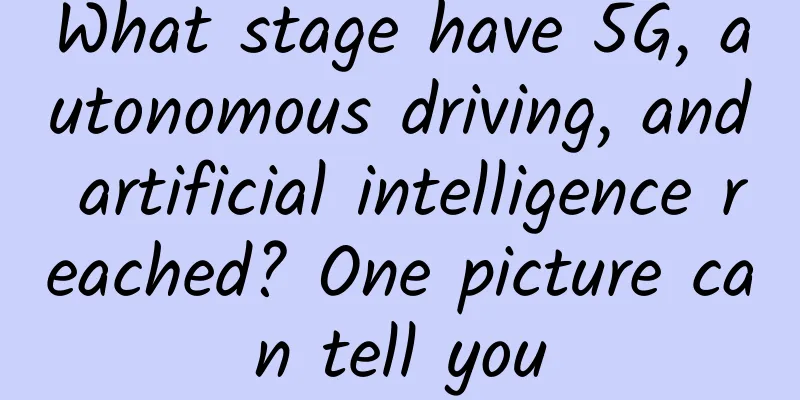What stage have 5G, autonomous driving, and artificial intelligence reached? One picture can tell you

|
On August 29, Gartner, the world's most authoritative IT market research and consulting company, released the 2019 Hype Cycle for new technologies (hereinafter referred to as the "Gartner curve"). Simply put, this is a curve that describes how social expectations change over time after the emergence of new technologies. It can show the degree of deviation between the market popularity of new technologies and actual development, thereby helping companies better utilize mature technologies and find potential opportunities. Gartner designed this analysis tool as early as 1995. Combining the judgments of analysts, experts and industry professionals, they drew a curve with ups and downs to list the most anticipated and commercially promising new technologies of the year and predict how long it will take for them to mature. The Gartner curve is composed of two superimposed curves, one is the "hype level" curve that reflects the public's inflated expectations of technology, and the other is the engineering or business maturity curve. Basically, new technologies that throw concepts and "tell stories" will be enthusiastically sought after by the media at first, but once they are verified by the market, the bubbles previously promoted by the new technology will slowly be blown away, and then enter the "high opening and low closing" stage, and then gradually climb to the maturity stage. From the coordinates, the Y-axis represents people's expectations for new technologies, while the X-axis corresponds to time. From left to right, there are five stages: "trigger period", "expectation expansion period", "trough period", "recovery period" and "maturity period". In addition, each technology is marked with the number of years required to reach production maturity. This year, Gartner selected 29 technologies from 2,000 and summarized the five major innovative technology trends that enterprise decision makers should consider. Brian Burke, vice president of research at Gartner, pointed out in an interview with CIO Dive that "artificial intelligence permeates all other trends." Five prominent trends Sensing and Mobility With the development of sensing technology and AI, autonomous robots will be able to better understand their surroundings. The sensing and mobility trend is characterized by the increasing ability of machines to move and manipulate objects, such as 3D sensing cameras that collect large amounts of data, and AI that can understand and apply this data in various scenarios. For example, light-cargo delivery drones will be able to better navigate and manipulate goods. In addition, companies betting on this technology trend should also consider augmented reality cloud, flying autonomous vehicles, and autonomous driving Levels 4 and 5. Augmented Human "(Human capability enhancement) is not about replacing human decision-making, but providing guidance when they perform tasks. This enhancement is like giving humans prosthetic limbs, both physically and cognitively," Burke said. This enhancement technology includes biochips and emotion AI. Among them, emotion AI is being used in insurance fraud detection. Different from the previous combination of claim analysis, computer programs and manual detection, with emotion AI, insurance companies can complete the detection through the caller's statement. This trend also includes personification, augmented intelligence, immersive workplaces and biotechnology (cultured or artificial tissue). Postclassical Compute and Comms For decades, classic core computing, communication, and integration technologies have developed rapidly by improving traditional architectures, resulting in faster CPUs, higher storage density, and increasing throughput. Classic computing and communications will then use completely new architectures. For example, the next-generation cellular network standard 5G will rely on core slicing and wireless edge, and these new architectures will promote a series of incremental technological improvements - enabling low-earth-orbit satellite systems to operate at an altitude of less than 1,200 miles from the ground. They will radiate to 48% of users who currently do not have access to the network, which will have a huge impact in terms of social significance and economic benefits. In addition, post-classical computing and communications also include technologies such as next-generation memory and nanoscale 3D printing. Digital Ecosystems Enterprises should break through the limitation of focusing only on their own industrial chain and share and cooperate with more enterprises, people and things across industries. The digital ecosystem is breaking down this traditional value chain and developing more seamless and flexible connections. Therefore, enterprises will look for solutions on the blockchain. Key technologies that enterprises can consider include DigitalOps, knowledge graphs, synthetic data, decentralized web, and decentralized autonomous organization. Advanced AI and Analytics Advanced analytics uses more sophisticated tools to automatically or semi-automatically examine data or content, and is often beyond the scope of traditional business intelligence (BI). For example, transfer learning focuses on storing existing problem-solving models and using them on other different but related problems. For example, a model used to identify cars can also be used to improve the ability to identify trucks. This advanced analysis can provide deeper insights, predictions, and recommendations. Other new technologies that fall on the Gartner Cycle include adaptive machine learning (adaptive ML), edge AI, edge analytics, explainable AI, AI platform as a service (AI PaaS), generative adversarial networks and graph analytics. AI is permeating all trends On this year's Gartner curve, autonomous flying cars, L4 and L5 autonomous driving, biotechnology, biochips, knowledge graphs, edge AI, AI PaaS and 5G overlap with last year. Among them, 5G has entered the expectation inflation period this year, and it is still 2-5 years away from technological maturity. Also entering this period are edge AI, low-Earth orbit systems, L5 autonomous driving, edge analytics, AI PaaS, biochips and chart analysis. The next generation of storage, 3D sensing cameras and L4 autonomous driving have slipped into the trough period, among which the latter is marked as more than 10 years away from technological maturity. In addition, this year Gartner put 21 new technologies on the curve, "eliminating" technologies such as the Internet of Things and blockchain, which fell into the expansion period last year. "This year Gartner will focus on the embodiment of new technologies," commented Computerworld, a foreign media, "but this does not mean that 'old' technologies are no longer important." For example, the Internet of Things is "decomposed" into branch technologies such as 3D sensor cameras, and blockchain technology is embodied by technologies such as distributed autonomous organizations. What remains unchanged is that this year's Gartner curve still emphasizes the reshaping of enterprises by AI. The future picture described by Gartner is that by 2029, leading companies in all major industries will use advanced analytics and automation to augment the workforce. These companies will also use blockchain to collaborate with multiple parties in complex digital ecosystems, and use sensor technology and next-generation computing to maximize efficiency, thereby standing out from the fierce competition. Brian Burke, vice president of Gartner Research, said in an interview with CIO Dive that "artificial intelligence permeates all other trends." AI can more finely sort through massive amounts of data, provide decision support, replace some manpower, and promote the development of other technologies. There is no doubt that AI will have a huge impact on the development of business. But in terms of using AI, companies first need to overcome the following obstacles: "The key to making any AI solution work is computing power, algorithms, massive data and employees who are skilled in using AI," said Soumendra Mohanty, executive vice president of IT company L&T Infotech. According to Gartner data, AI will create 2.3 million jobs by 2020. At the same time, 50% of organizations will lack relevant AI and data analysis talents. |
<<: Link aggregation, redundancy, stacking, and hot backup of core switches
>>: Java performance optimization RPC network communication
Recommend
What is Bluetooth Low Energy?
Bluetooth Low Energy is a new Bluetooth wireless ...
How difficult it is to increase network speed and reduce fees
In response to the livelihood issue of "spee...
Will an Ethernet splitter reduce my internet speed?
This article provides a detailed summary of Ether...
What are the 5G scenarios in digital transformation?
It is predicted that by 2025, there will be 1.2 b...
ADLINK and Wind River Systems establish joint lab to focus on remote integration and testing of NFV solutions
[51CTO.com original article] On February 16, 2017...
Wireless Technology Review in 2016: 3.5 GHz Prompts New Changes in Spectrum Sharing
According to foreign media reports, in the past y...
If you are in the communications industry, you will be out if you don’t understand these nine 5G issues
China's 5G era has arrived as promised! The f...
EtherNetservers: $14.95/year-1GB/40G SSD/1TB@10Gbps/Los Angeles & New Jersey & Miami & Germany data centers
While other vendors are offering KVM, EtherNetser...
Next generation WiFi: There is still signal one kilometer away!
[[433169]] The Wi-Fi Alliance announced on Tuesda...
The winner of Huawei Ecosystem Partner Elite Competition is finally revealed, and the cloud ecosystem embarks on a new journey
[51CTO.com original article] On October 28, after...
Writing crawlers has become "prison programming" because you don't understand the Robots protocol
[[386960]] It is easy to write Python crawlers, b...
WebHorizon: $10.56/year-256MB/5G SSD/200GB/Japan VPS
WebHorizon is a foreign VPS hosting company estab...
Guanmai Technology CTO Miao Quan: Steadily enter the SD-WAN market and be prepared to deploy 5G
[51CTO.com original article] From the emergence t...
my country successfully launched the communication technology experimental satellite No. 6: mainly used for satellite communications, radio and television, data transmission and other services
[[380675]] CCTV News reported on February 5 that ...
How NFV systems converge virtual network services at the edge
Think back to the days before smartphones, when p...









